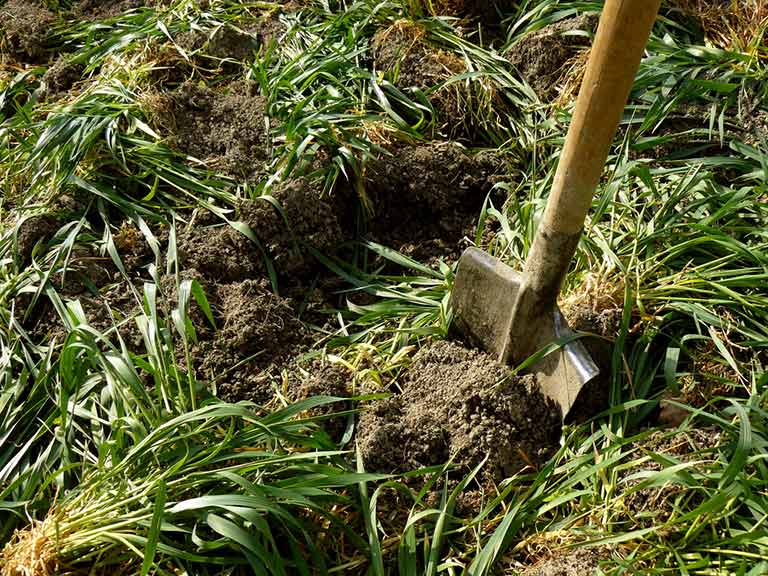What is taken out of the garden soil by crops or ornamental plants must be returned to the soil sooner or later so that it is not permanently leached out. A particularly ecological method of revitalising the soil is green manuring. Green manuring in autumn has many advantages and should also always be preferred to leaving beds fallow over the winter.
Contents
What is green manuring?
Green manuring is not fertilisation in the conventional sense, but a type of intercropping that is intended to enrich the soil with nutrients and generally enhance its value. Various green manure plants are used for this purpose, which can serve different purposes. At the end of the crop, the plants are usually mulched and worked into the soil. This has several advantages:
Important plant species for green manuring are legumes (for example peas, lupins, vetches or clover). The legumes form a symbiosis with bacteria of the Rhizobium genus in their root nodules.
This binds nitrogen from the air. Chopping and incorporating the green manure enriches the soil with nitrogen. The leaching of nutrients over the winter is prevented, because the plants absorb them from the soil during their growth. Thanks to dense seeding, the soil is protected from drying out, frost and erosion.
Weeds no longer get through so easily. You can also sow green manure between rows of plants, for example, while the crop is still growing.
The roots of the plants and their metabolic processes loosen the soil – depending on the type and root system of the plants also in deeper soil layers. When the green manure is finally added to the soil, the humus content of the soil increases.
Green manure promotes soil life, as the plant residues and metabolic products of the roots provide food for countless microorganisms and microorganisms. If the green manure remains for a year or more, many of the plants prove to be excellent bee pasture.
Green manuring in autumn – when does it make sense?
In principle, you can sow green manure from spring to autumn. Which time is right always depends on which crops you are growing in your garden. Green manuring in autumn is particularly useful if the beds have been harvested or withered by the beginning of autumn and you do not plan to plant a subsequent crop over the winter.
It is important to sow the green manure as soon as possible so that it can grow sufficiently before winter – between the end of August and the beginning of September is considered a good time. Green manure is a sensible way of bridging breaks in cultivation. The soil is protected from wind and weather and receives new nutrients. You can then work the green manure into the soil before sowing again in spring.
If you want to give your garden soil a particularly intensive treatment, you can plant green manure for a whole year. Choose hardy and perennial plants and work them into the soil next autumn or even the following spring.
Tip: In addition to green manure in autumn, dry leaves or straw can also be worked into the soil.
If, instead, the next crop is to follow in late autumn, for example, if you want to plant winter vegetables, you should choose fast-growing plants that you can then dig into the soil before winter. However, there should be at least three to four weeks between working the leaf mass into the soil and planting the next crop.
Planting in autumn – instead of digging up
For a long time it was common practice to dig up the vegetable beds in the autumn of the harvest and leave them to themselves for the winter. However, this has major disadvantages: the soil erodes, nutrients are washed out and soil life suffers accordingly. Green manuring is an easy-to-implement and ecologically valuable alternative practice here.
Which plants are suitable for green manuring in autumn?
For short-term green manuring that is to be dug in the same year or directly in spring, hardy plants do not necessarily have to be used. Buckwheat, summer vetch, flax or rough oats are excellent for quickly improving the soil before the next crop. Yellow mustard or tansy phacelia grow quickly, so sowing them before winter is still worthwhile.
If, on the other hand, the green manure is to remain in place for a year or more, it is better to use hardy plants. For example, winter vetch, red clover, incarnate clover, winter rye or winter wheat are suitable.
A mixture of winter-hardy and freezing plant species is also possible. In addition, the specialised trade already offers seed mixtures that sensibly coordinate different species so that all the advantages of green manuring come into play.
Green manure in autumn: sowing tips
Carefully loosen the top layer of soil before sowing. Plant residues from the previous crop can simply be worked in.
Spread the seeds as evenly and generously as possible.
Cover the seeds with a little soil so that the fine seeds stay in place.
Finally, water the sowing generously - but with as fine a stream of water as possible.

